The Fall Harvest:
Reaping the rewards
of agricultural innovation
and sustainability
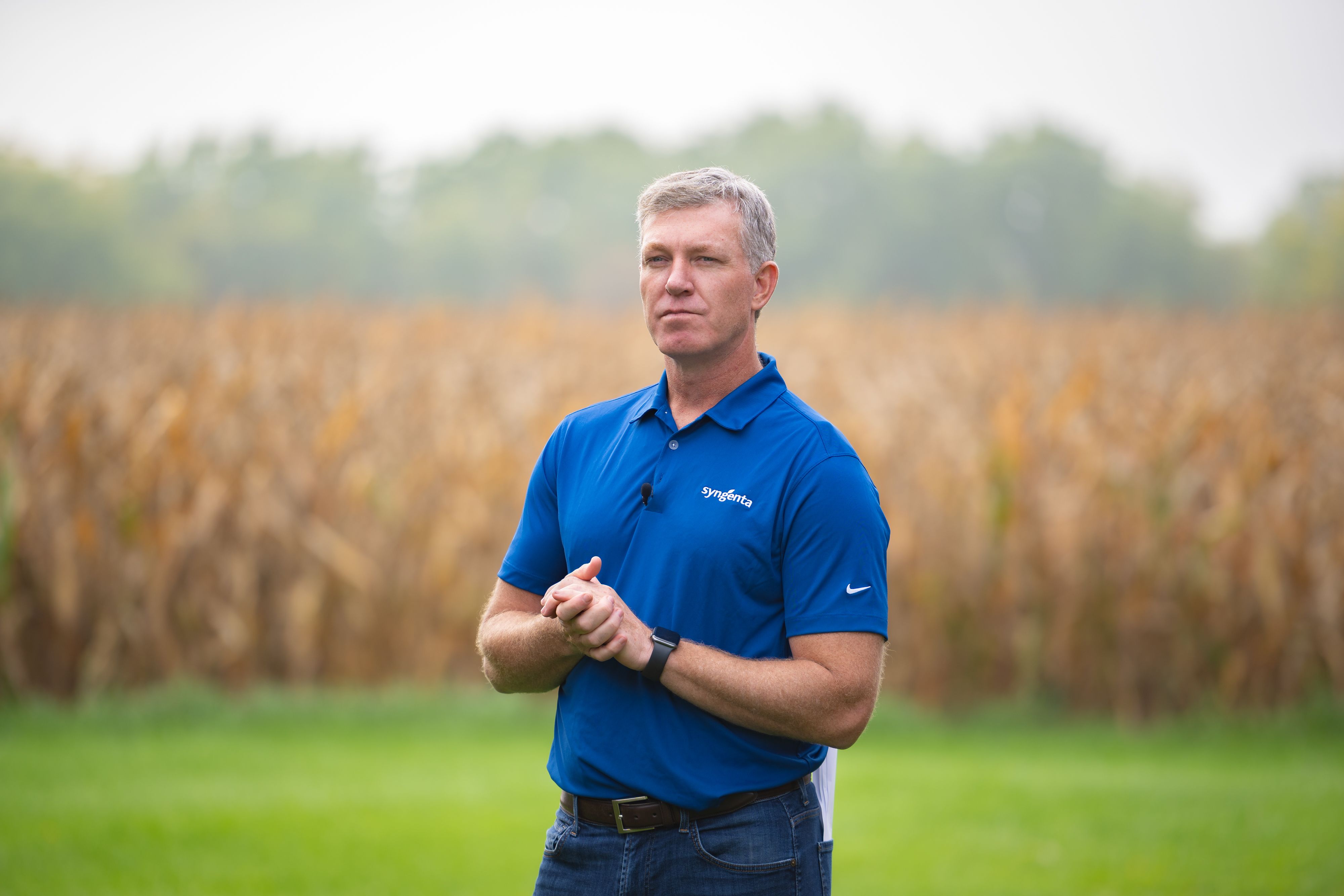
On a 3,000-acre farm in the U.S. state of Illinois, the fall harvest was in full swing. A combine combed the fields, reaping corn and soy that were coming in at high yields despite an unusually dry summer. The work, which began at dawn, would continue well past sundown, illuminated by a full harvest moon.
“This is my favorite time of the year,” said the farmer, Jeff Rowe, whose family has been working the land in this region for five generations. “The fall is when all of the work and decisions that go into creating a crop come to fruition.”
Rowe’s career is doubly invested in agriculture. He is also President of Syngenta Crop Protection and will become CEO of Syngenta Group in January.
Around the world, the harvest, a time-honored tradition, is changing in important ways. A 60-year trend of steadily increasing productivity has slowed in recent years, due to “weather shocks” associated with climate change and other factors, according to the USDA. More farms are responding to these challenges by adopting various sustainable practices that help re-establish healthy soil, conserve water and reduce carbon emissions, among other benefits.
As agriculture seeks the best of both worlds—higher productivity and environmental sustainability—farmers are pursuing these dual objectives with a combination of the latest agricultural products and digital technologies. These include disease-resistant seeds and pest-detection sensors, as well as nature-positive growing and harvesting methods.
“The old way of doing things isn't going to be good enough in the future,’’ Rowe said, “so we always have to find new ways.”
A farming future,
informed by the past
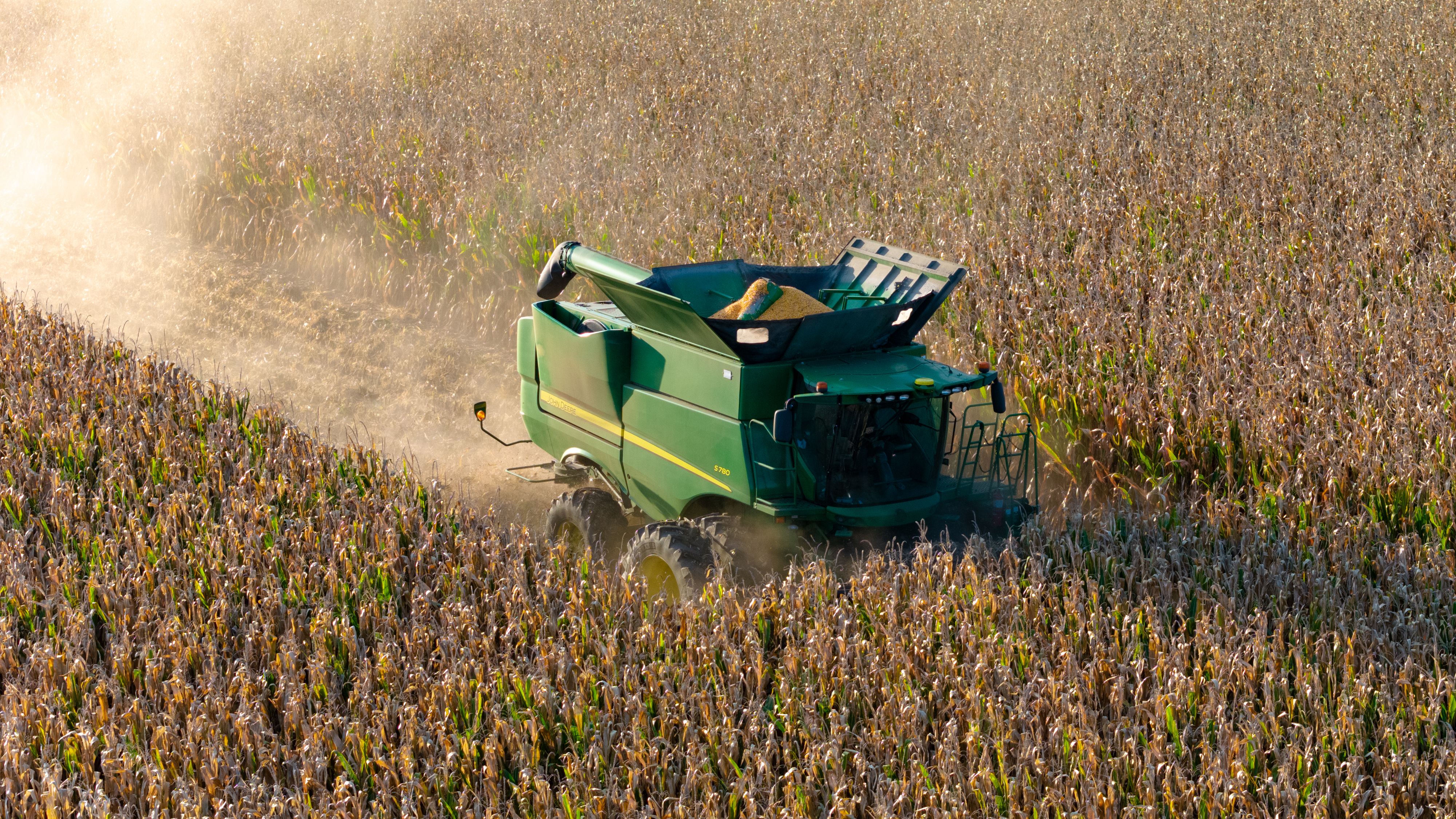
Agricultural progress, to be sure, isn’t entirely dependent on what’s next in research and development. The knowledge and best practices handed down from earlier generations of growers are equally important.
This melding of science and lessons learned is evident on family farms everywhere. And it helps explain how the Rowe farm, located in the corn belt of north central Illinois, enjoyed higher-than-expected yields of corn and soybeans during the fall of 2023, despite an unusually warm and dry summer.
The Rowe farm is a multi-generational operation. Jeff’s parents, Dean and Carol Rowe, keep the farm running year round, with help from the rest of the family. “No matter where I am in the world, when it comes to this time of year, I get excited to go back home and harvest,” said Jeff Rowe. “It's the result of all those tough decisions and hard work.”
A family effort
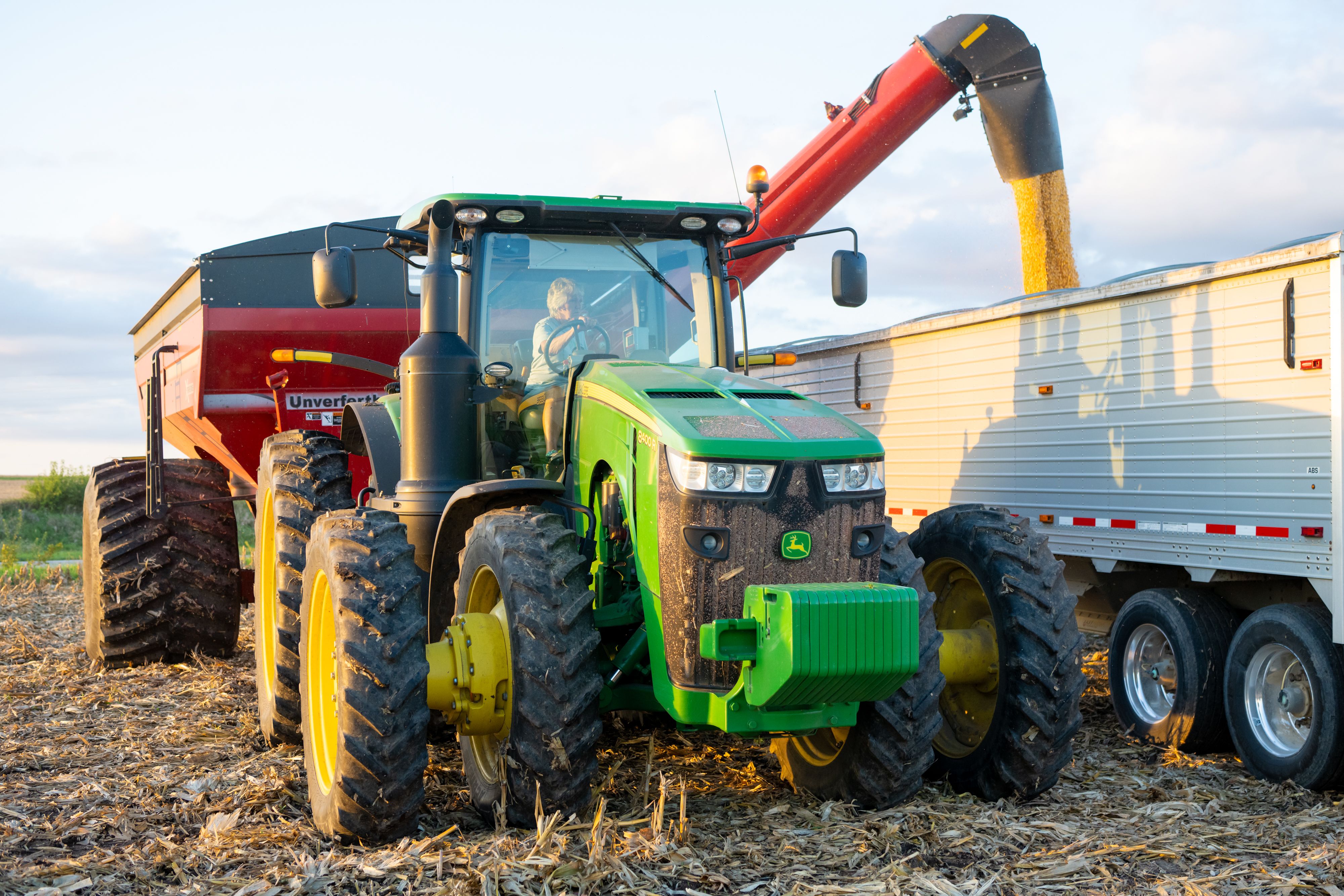
In late September, the harvest was in high gear at the Rowe farm, with Jeff driving the combine, Carol operating the tractor and grain cart, and Dean moving truckloads of corn to a nearby silo for drying and storage. Later in the day, Jeff’s daughter Emma arrived with pizza, so the work could continue as the sun went down and a harvest moon rose on the horizon.
This process of harvesting and hauling corn and soybeans goes on for weeks through September and into October. Once done, the ground is covered with crop residue, left behind by the no-till and low-till cutting — methods that have been practiced on the Rowe farm for years. More recently, the Rowes have begun experimenting with cover crops, which are non-commercial plants that support biodiversity and help control weeds and pests between growing seasons.
These and other techniques are part of regenerative strategies, which are being implemented more widely on farms across the U.S. and in other countries. Low-till field management helps prevent erosion, retain moisture and contribute to soil health. And cover crops have the added benefit of capturing carbon from the atmosphere and returning it to the soil, a vital step in reversing the harmful effects of greenhouse gas (GHG) emissions. Besides improving the organic content of the soil, the minimal plowing associated with no-till and low-till planting and harvesting also help keep the captured carbon locked in the ground.
The cover crop on the Rowe farm is rye. “You’ve got roots in the ground and good cover on the soil throughout the wintertime, which helps preserve the soil so it doesn’t blow away and erode,” Jeff Rowe said. “Then when you come back in the spring to plant your regular crop, you’ve got that cover crop to help with soil health.”
The Rowe farm has begun measuring and tracking soil-health indices—texture, surface hardness, water capacity, organic matter and more—as part of a wider Syngenta project called BinBuster. Because soil can take up to 10 years to repair, build and show measurable improvements, such efforts tend to be long-term undertakings.
Fortunately, the early results are promising at the Rowe farm after just a few years. There’s already been “a pretty rapid increase in organic matter in the soil,” said Jeff Rowe.
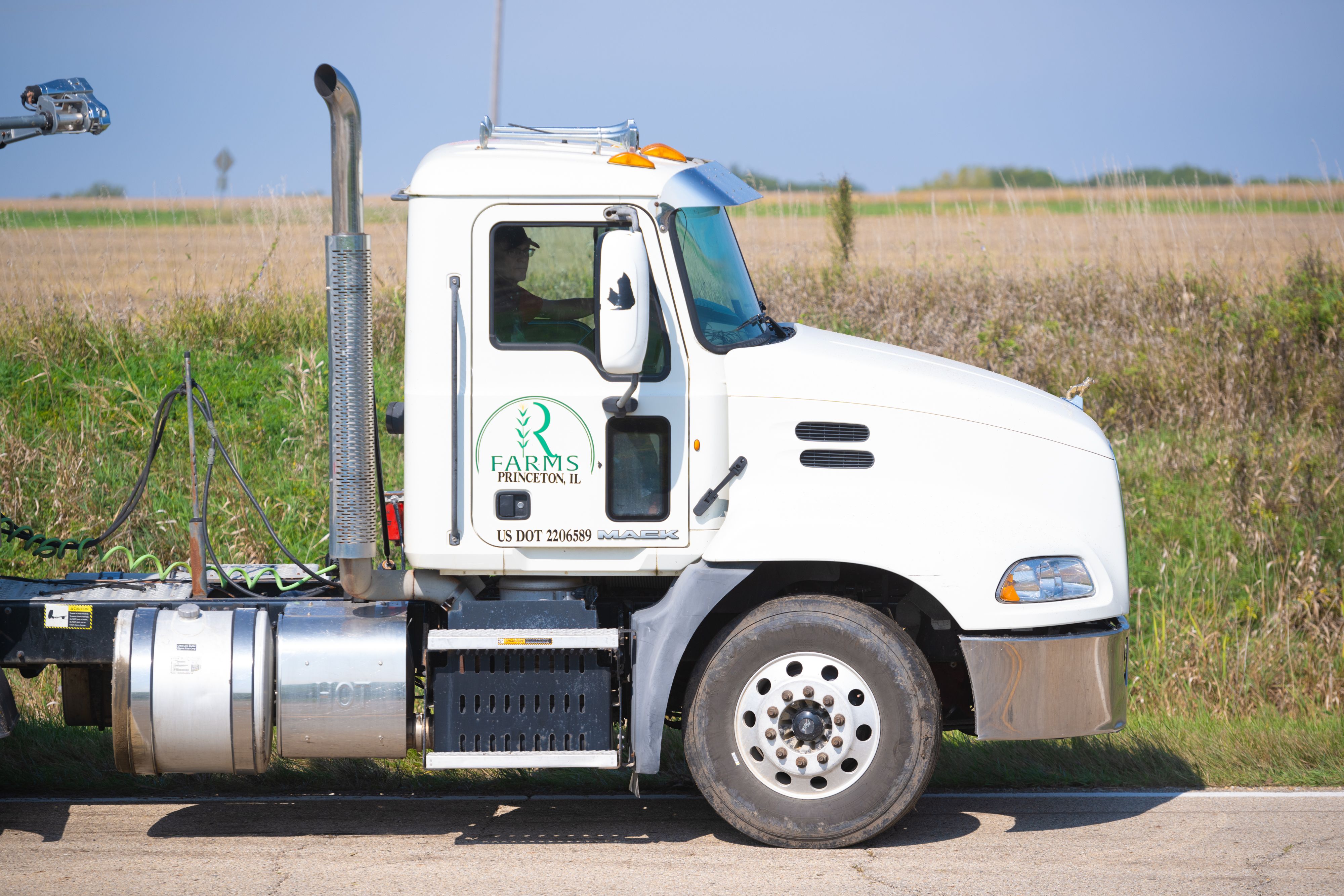
Dean Rowe moving truckloads of corn to a nearby silo
Dean Rowe moving truckloads of corn to a nearby silo
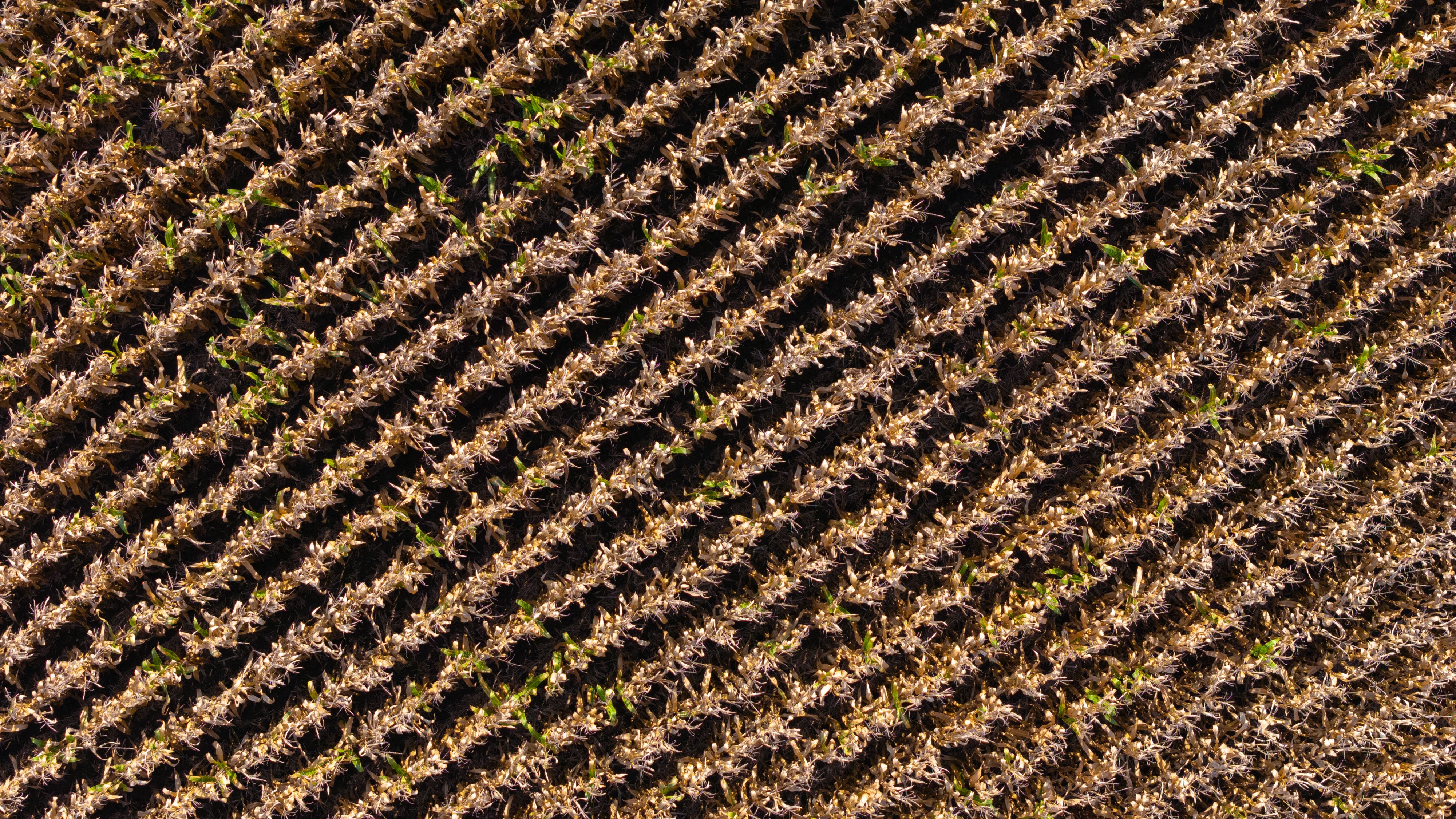
After the harvest, the ground is covered with crop residue, left behind by the no-till and low-till cutting — methods that have been practiced on the Rowe farm for years.
After the harvest, the ground is covered with crop residue, left behind by the no-till and low-till cutting — methods that have been practiced on the Rowe farm for years.
In late September, the harvest was in high gear at the Rowe farm, with Jeff driving the combine, Carol operating the tractor and grain cart, and Dean moving truckloads of corn to a nearby silo for drying and storage. Later in the day, Jeff’s daughter Emma arrived with pizza, so the work could continue as the sun went down and a harvest moon rose on the horizon.
This process of harvesting and hauling corn and soybeans goes on for weeks through September and into October. Once done, the ground is covered with crop residue, left behind by the no-till and low-till cutting — methods that have been practiced on the Rowe farm for years. More recently, the Rowes have begun experimenting with cover crops, which are non-commercial plants that support biodiversity and help control weeds and pests between growing seasons.

Dean Rowe moving truckloads of corn to a nearby silo
Dean Rowe moving truckloads of corn to a nearby silo
These and other techniques are part of regenerative strategies, which are being implemented more widely on farms across the U.S. and in other countries. Low-till field management helps prevent erosion, retain moisture and contribute to soil health. And cover crops have the added benefit of capturing carbon from the atmosphere and returning it to the soil, a vital step in reversing the harmful effects of greenhouse gas (GHG) emissions. Besides improving the organic content of the soil, the minimal plowing associated with no-till and low-till planting and harvesting also help keep the captured carbon locked in the ground.
The cover crop on the Rowe farm is rye. “You’ve got roots in the ground and good cover on the soil throughout the wintertime, which helps preserve the soil so it doesn’t blow away and erode,” Jeff Rowe said. “Then when you come back in the spring to plant your regular crop, you’ve got that cover crop to help with soil health.”

After the harvest, the ground is covered with crop residue, left behind by the no-till and low-till cutting — methods that have been practiced on the Rowe farm for years.
After the harvest, the ground is covered with crop residue, left behind by the no-till and low-till cutting — methods that have been practiced on the Rowe farm for years.
The Rowe farm has begun measuring and tracking soil-health indices—texture, surface hardness, water capacity, organic matter and more—as part of a wider Syngenta project called BinBuster. Because soil can take up to 10 years to repair, build and show measurable improvements, such efforts tend to be long-term undertakings.
Fortunately, the early results are promising at the Rowe farm after just a few years. There’s already been “a pretty rapid increase in organic matter in the soil,” said Jeff Rowe.
A global challenge
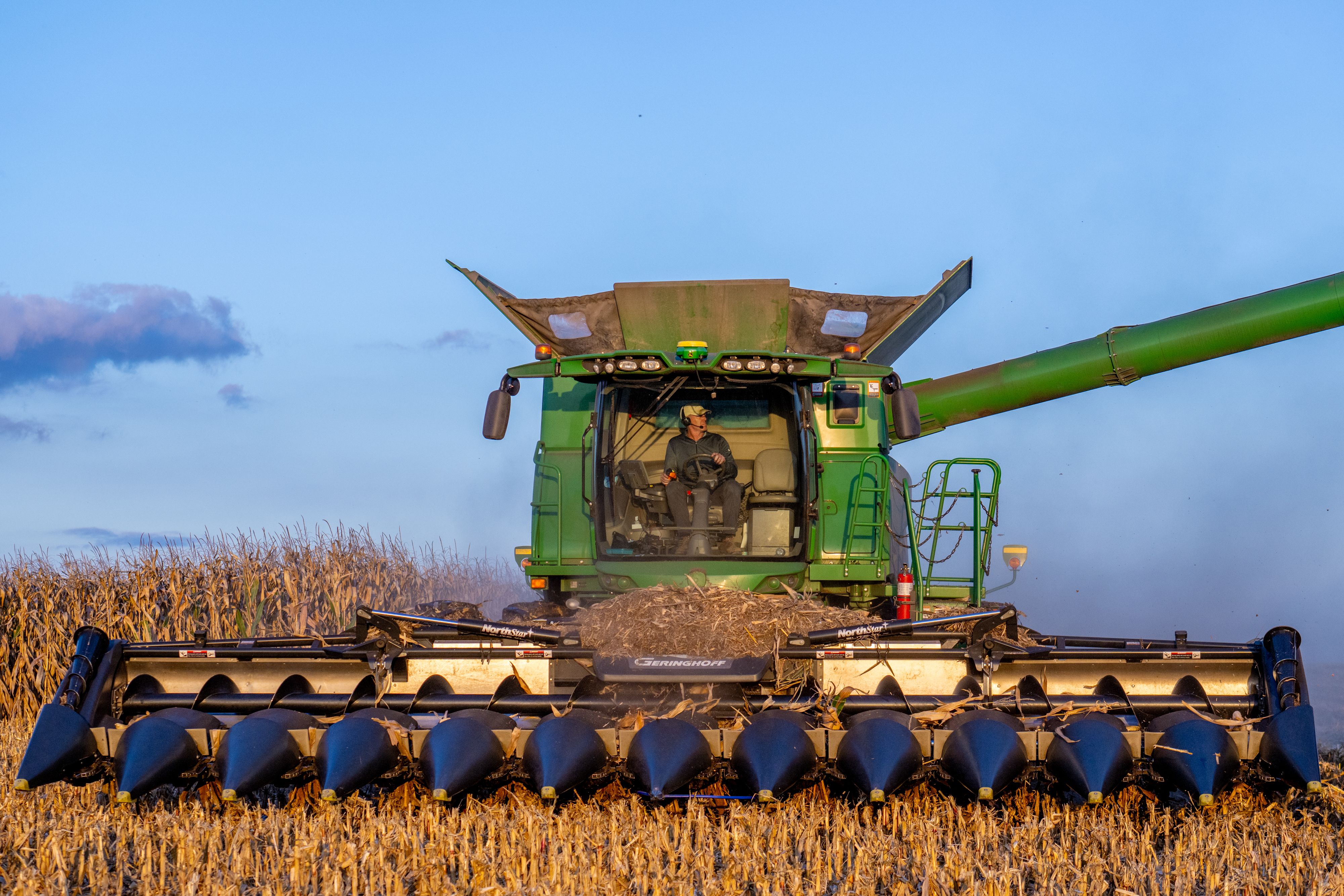
Drive along any of the interstate or two-lane highways that run through the U.S. corn belt and you’re likely to see farm combines criss-crossing the fields during the harvest months.
At the Rowe farm, as the combine bins filled and refilled, 18-wheel semi trucks made constant round trips from the fields to the silos, hauling up to 55,000 pounds of corn or soybeans with each load. During this harvest, the farm produced in excess of 240 bushels of corn per acre and more than 80 bushels of soybeans per acre on some days — both well above the national averages of 174 bushels of corn and 50 bushels of soybeans that was forecast by the USDA.
That’s all the more impressive considering the unusually dry conditions. The period from April to June was the sixth driest on record in Illinois, according to Trent Ford, the state’s official climatologist. “Moderate to extreme drought covered most of the state coming into July,” Ford observed.
Despite the dearth of rain in many parts of U.S. farm country and record heat in various locales, U.S. overall corn production was nonetheless predicted to be 15.1 billion bushels in 2023, a 10% increase over the previous year, according to the USDA. Soybean production is expected to decline 3%, to 4.15 billion bushels, although that is largely a result of a 4% decrease in soy acres planted.
Continuing increases in yields will be needed to feed a global population that, according to the United Nations, is on track to approach 10 billion people by 2050. USDA calculates that agricultural productivity must increase by 1.73 percent annually to feed the world by then. By comparison, global agricultural productivity grew at just 1.12 percent per year from 2011 to 2020—short of what will be needed in the decades ahead.
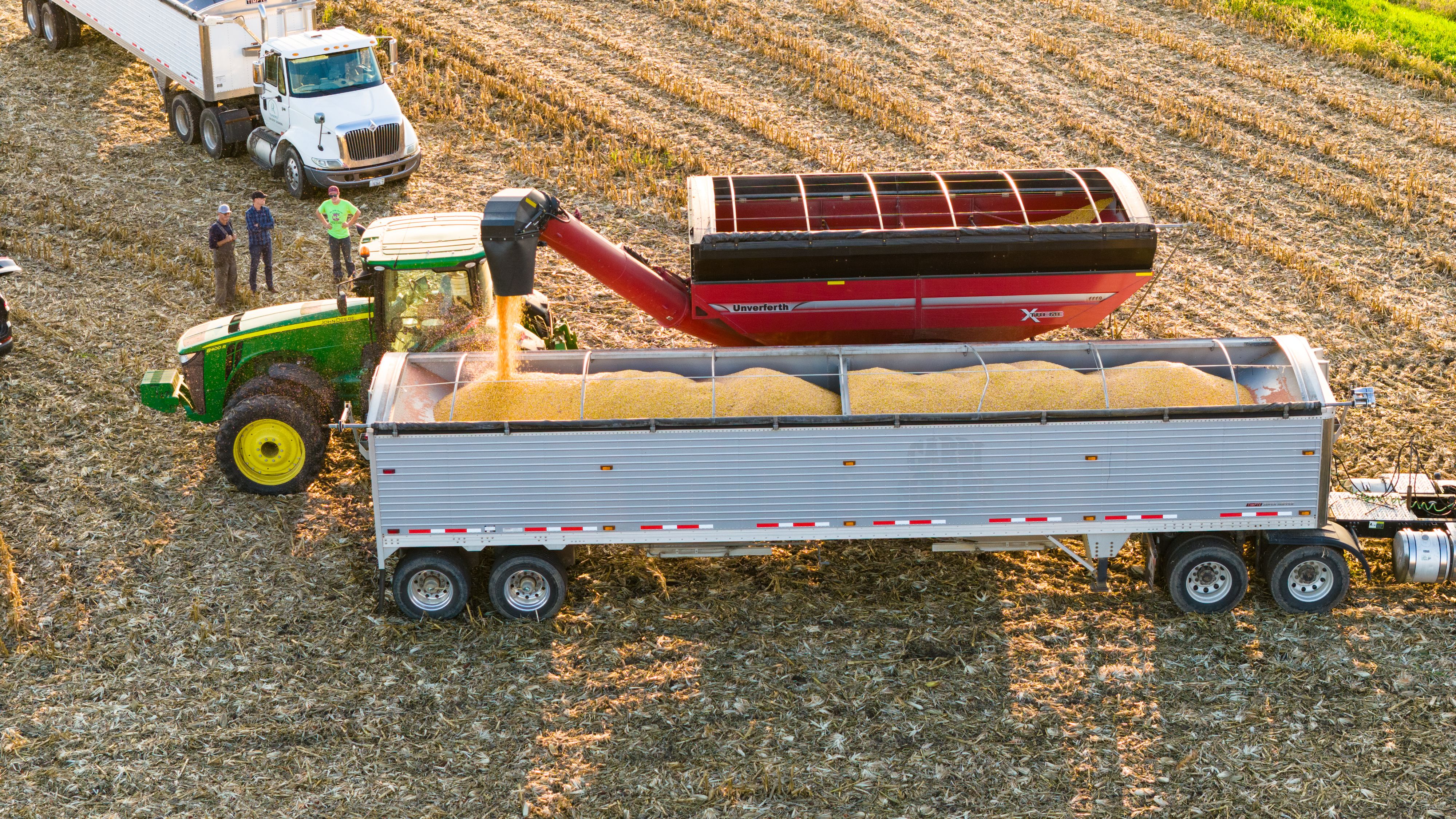
18-wheel semi trucks made constant round trips from the fields to the silos, hauling up to 55,000 pounds of corn or soybeans with each load.
18-wheel semi trucks made constant round trips from the fields to the silos, hauling up to 55,000 pounds of corn or soybeans with each load.
Drive along any of the interstate or two-lane highways that run through the U.S. corn belt and you’re likely to see farm combines criss-crossing the fields during the harvest months.
At the Rowe farm, as the combine bins filled and refilled, 18-wheel semi trucks made constant round trips from the fields to the silos, hauling up to 55,000 pounds of corn or soybeans with each load. During this harvest, the farm produced in excess of 240 bushels of corn per acre and more than 80 bushels of soybeans per acre on some days — both well above the national averages of 174 bushels of corn and 50 bushels of soybeans that was forecast by the USDA.

18-wheel semi trucks made constant round trips from the fields to the silos, hauling up to 55,000 pounds of corn or soybeans with each load.
18-wheel semi trucks made constant round trips from the fields to the silos, hauling up to 55,000 pounds of corn or soybeans with each load.
That’s all the more impressive considering the unusually dry conditions. The period from April to June was the sixth driest on record in Illinois, according to Trent Ford, the state’s official climatologist. “Moderate to extreme drought covered most of the state coming into July,” Ford observed.
Despite the dearth of rain in many parts of U.S. farm country and record heat in various locales, U.S. overall corn production was nonetheless predicted to be 15.1 billion bushels in 2023, a 10% increase over the previous year, according to the USDA. Soybean production is expected to decline 3%, to 4.15 billion bushels, although that is largely a result of a 4% decrease in soy acres planted.
Continuing increases in yields will be needed to feed a global population that, according to the United Nations, is on track to approach 10 billion people by 2050. USDA calculates that agricultural productivity must increase by 1.73 percent annually to feed the world by then. By comparison, global agricultural productivity grew at just 1.12 percent per year from 2011 to 2020—short of what will be needed in the decades ahead.
Innovation is the answer
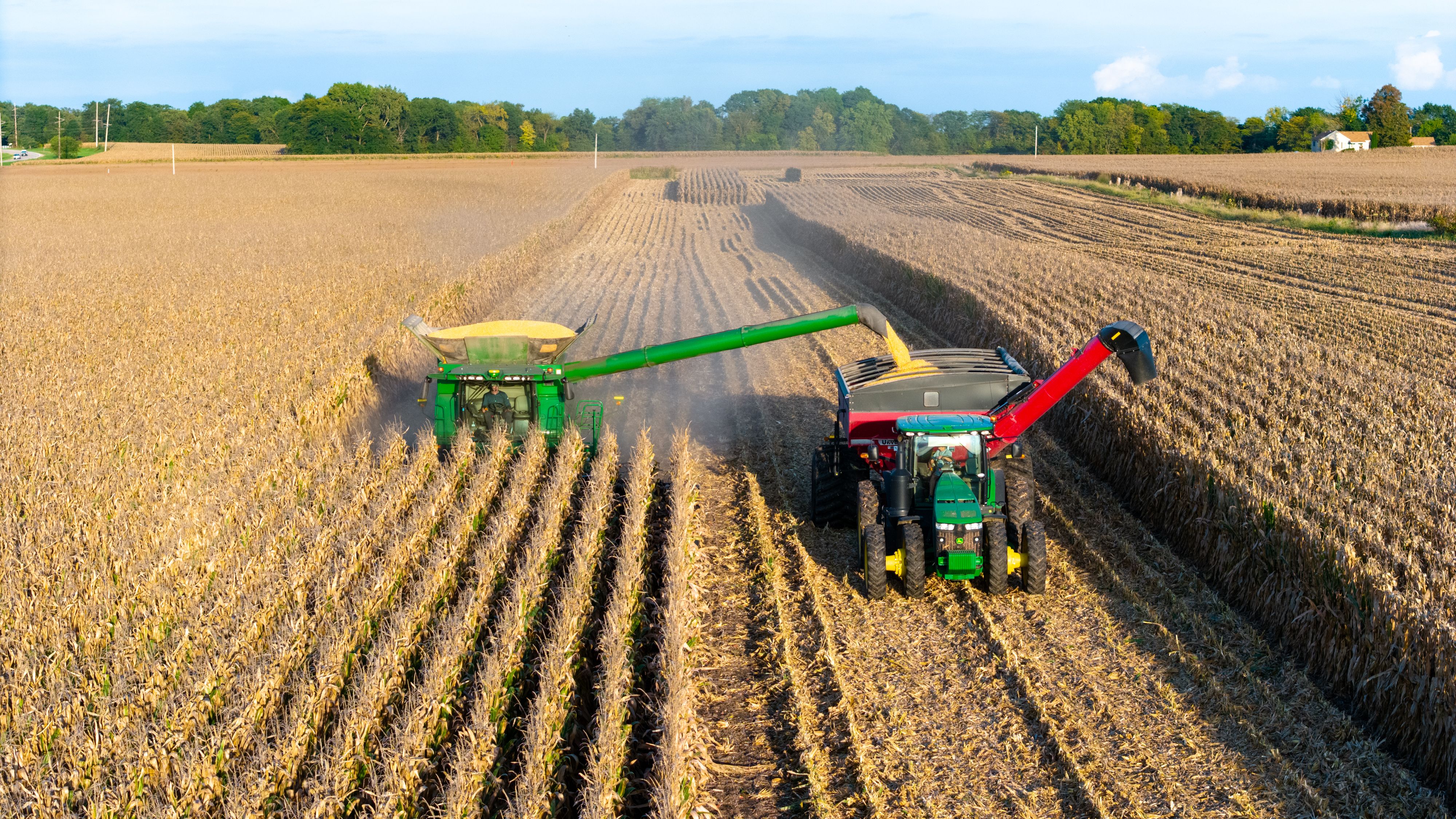
How can farmers around the world meet this escalating demand? Agricultural innovation in products and practices, coupled with an even greater commitment to sustainability, point the way forward.
The Rowe farm illustrates the potential of this approach. “We had an extremely dry year and not much rain through the most critical part of the season,” said Jeff Rowe. “Despite those difficult weather conditions, we're seeing very consistent, solid yield performance. A big part of that is because of the innovation.”
In addition to conservation tillage, cover crops and soil-health management, the farm uses field-level weather stations and spore sensors to monitor crop health and evaluate the risk of disease. What’s more, the Rowe farm makes wide use of Syngenta’s market-leading products, including Golden Harvest corn and soybean seeds, Miravis fungicide, Acuron herbicide, Yieldon biostimulant and Warrior insecticide.
All of that builds on the experience gained through the generations of Rowe family farming. Working alongside his parents, Jeff Rowe has been the beneficiary of an in-the-field education. Now, at every opportunity, he shares what he has learned with his children and a new generation of farmers.
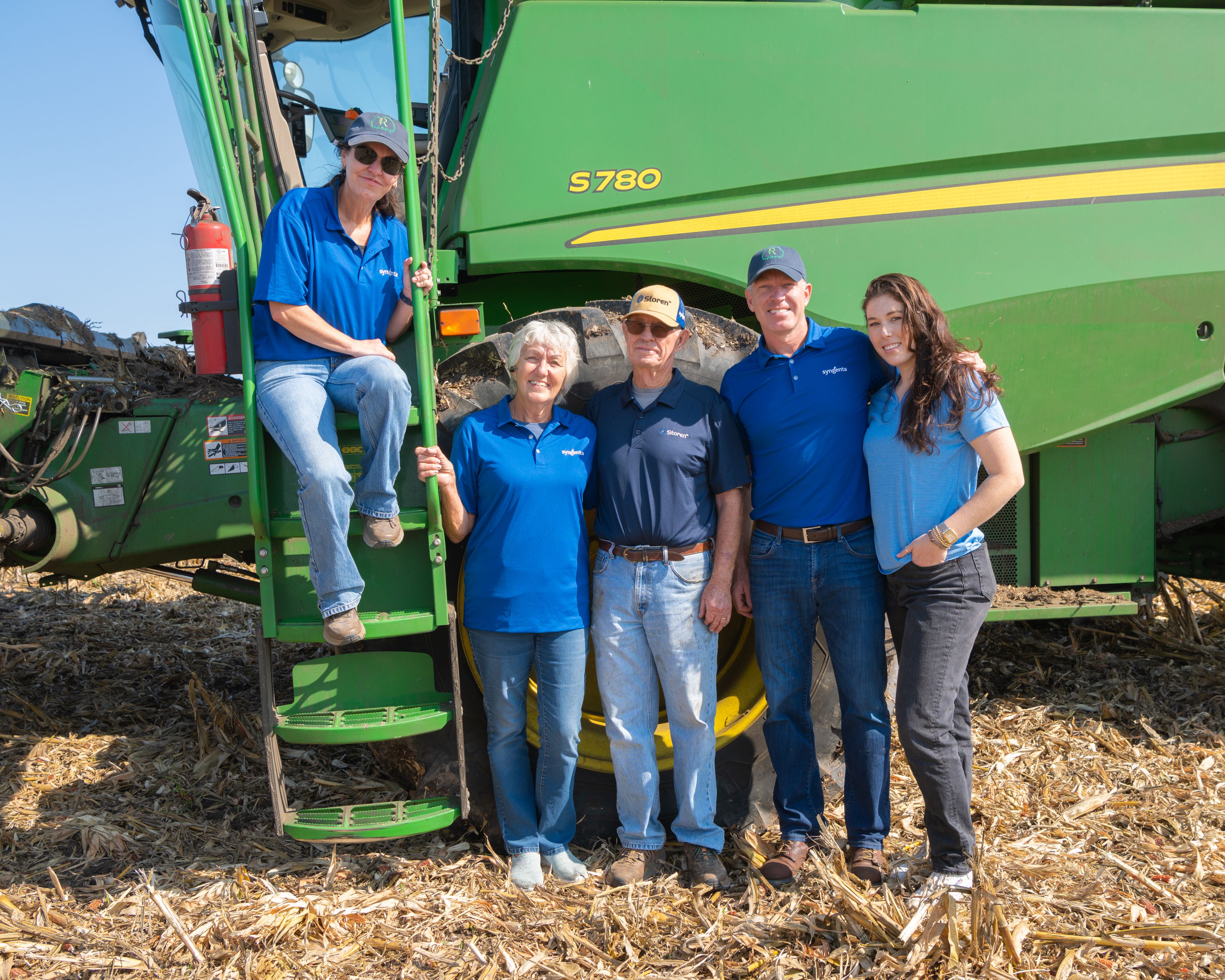
A farming family: Jeff Rowe’s sister, Sara Rowe, seated. His mother, Carol; his father, Dean; Jeff; and his daughter, Emma.
A farming family: Jeff Rowe’s sister, Sara Rowe, seated. His mother, Carol; his father, Dean; Jeff; and his daughter, Emma.
How can farmers around the world meet this escalating demand? Agricultural innovation in products and practices, coupled with an even greater commitment to sustainability, point the way forward.
The Rowe farm illustrates the potential of this approach. “We had an extremely dry year and not much rain through the most critical part of the season,” said Jeff Rowe. “Despite those difficult weather conditions, we're seeing very consistent, solid yield performance. A big part of that is because of the innovation.”

A farming family: Jeff Rowe’s sister, Sara Rowe, seated. His mother, Carol; his father, Dean; Jeff; and his daughter, Emma.
A farming family: Jeff Rowe’s sister, Sara Rowe, seated. His mother, Carol; his father, Dean; Jeff; and his daughter, Emma.
In addition to conservation tillage, cover crops and soil-health management, the farm uses field-level weather stations and spore sensors to monitor crop health and evaluate the risk of disease. What’s more, the Rowe farm makes wide use of Syngenta’s market-leading products, including Golden Harvest corn and soybean seeds, Miravis fungicide, Acuron herbicide, Yieldon biostimulant and Warrior insecticide.
All of that builds on the experience gained through the generations of Rowe family farming. Working alongside his parents, Jeff Rowe has been the beneficiary of an in-the-field education. Now, at every opportunity, he shares what he has learned with his children and a new generation of farmers.
“Be open to new ideas,” Jeff Rowe advises. “Ask a lot of tough questions. Apply what you’re learning, what you’re seeing, your experience. And then ask, ‘Is there a better way?’”
For an increasing number of farmers around the world, sustainable agriculture is the answer to that question. It produces higher yields, while lowering the climate and environmental impact. That should mean long-term productivity and prosperity for farmers—and a greater ability for the earth to sustain itself.
“This isn’t just about reducing your footprint,” Rowe said. “It’s about making something better.”

